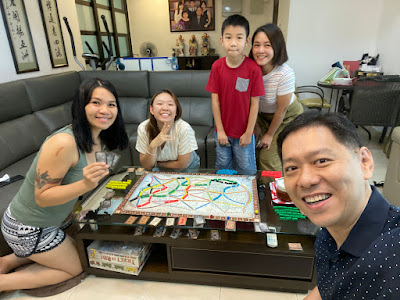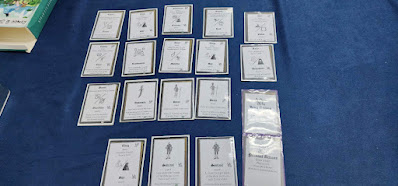Due to my work, I created a giant version of Pandemic. I made this for
a team-building event. I asked younger daughter Chen Rui to draw a giant map
based on the standard map. Most of the details were the same, but I needed it
to be 6 feet by 4 feet. Looking at this photo you can't really tell how big
the map is. You'll need to look at the map when placed in my sitting room next
to the furniture.
I needed the map to be big because I planned to have this activity accommodate
20 to 40 participants. The map needed to be big enough so that most
participants could easily see the various details on the map. I did not change
the game rules. The changes I made were in how this activity was to be
executed by four teams as opposed to this being a game played by four players.
Within each team there would be members assigned to different tasks. There
would be some communication challenges thrown in. Pandemic when
used well is a great team-building and training activity.
I bought most of the activity props. I needed to get a copy of
Pandemic too, because I used the cards from the actual game. For
the rest, I had to hunt everywhere to find equivalent large sized components.
I arranged to playtest this giant version of Pandemic. Not for
gameplay, since I didn't change that, but for making sure the components
worked well. My dining table was not big enough for the map. I needed to add
one more table and a white board (see bottom right) to create enough flat
surface for the whole map.
I used toy cars as player pawns. The white cube is a die for prototype-making.
I used it as a research centre. I used square wooden blocks as diseases. I
bought them at Daiso and spray painted them. One problem with the toy cars was
players could not resist playing with them. This is the kind which you can
pull back and then release to have it dart forward. Chen Rui kept playing with
her car, knocking over game components on the map.
I prepared four spare cars in the same four colours as those on the map, and
placed them in front of the four players as reminders to tell which one on the
map was their car. Here we have one flaw. In the original game, the player
pawn colours match the player character colours. I couldn't find large player
pawns to match all the character cards, so I went with toy cars.
I put the character cards into identity card holders and attached lanyards. In
each team there would be one member wearing this, and his or her job was to
remind the whole team they needed to fully utilise the character
ability.
I changed this part of the game board. In the original there are only four
circles. When you manage to cure a disease, you put a marker into the circle.
If you manage to eradicate the disease, you flip the marker to the other side,
which shows a different symbol. In the giant version, I wanted something which
looked like a table, each row being a different status. The four little
bottles are markers you can advance downwards.
Game in progress
For the outbreak marker and the infection rate marker, I used this type of
whiteboard magnet which can be found at stationery shops.
I found large transparent plastic cans for the four diseases.
These four small bottles are status markers for the four diseases. Originally
I thought about half filling the bottles with liquid in the four disease
colours. I later changed my mind because I was worried the liquid might leak
and damage the other components.
I feel bad for having moved Jakarta into the Indian Ocean. The city locations
are not meant to be accurate.
We played the giant version with just the four of us. The team-building would
have 20+. It's a little too big for four players, but a trial run was good to
help iron out any issues.
We won rather easily. That was not surprising since my daughters and I had
played Pandemic and its variants many times. Vanilla
Pandemic was easy for us. We did have a newbie Joti, but he picked up
quickly under our guidance. One thing I learned from this playtesting was when
I conducted the team-building activity, I should refrain from giving too much
guidance. I should only teach the rules and not give any tips. If I were to
guide the participants on how to play, it would effectively be me playing and
not them learning.
The activity during the team-building workshop took about 2.5 hours. I told
the attendees that had a very difficult mission, because they had to manage
not just COVID-19, but also COVID-20, COVID-21 and COVID-22.
Learning the rules was challenging for them. After all they were not regular
gamers. However they were sporting and participative. There was plenty of
discussion and debating.
I created many player roles and assigned them to more than half the
participants. I don't mean the roles in the game like medic, scientist and
operations expert. I mean player roles I created when I turned the game into a
team activity involving four teams. Naturally there was a team leader for each
team. I had four disease controllers whose jobs were to handle the disease
cubes. No one else was allowed to touch the disease cubes but them four. I had
card holders who were responsible for drawing and handling player cards. No
one else were allowed to touch the player cards. One player role which turned
out to be quite fun (but also busy for the guy assigned) was the infection
officer. His job was to draw and announce the two infection cards at the end
of every turn. Basically he was the bringer of bad news. That stage of a game
turn was called Breaking News.
I did not manipulate the game setup or the two card decks to make it easier or
harder for them to win. I just let randomness run its course.
Pandemic is well balanced and a random setup normally won't create
too extreme a situation. Also the point of the exercise was not to
intentionally let them win so that they would feel good, or to make them lose
so that they would learn from failure. It was an exercise to challenge their
teamwork, communication, collaboration, strategic awareness and strategic
planning.
Adrian was the card holder for Team 3 (red team) and his job included drawing
player cards. He happened to be the only person to ever draw Epidemic cards.
Everyone blamed him for having unlucky hands. It really wasn't his fault. He
just happened to be assigned the job. Look at his nervousness as it was time
to draw player cards again. At this point he had already drawn two Epidemic
cards.
In the end, they only managed to cure two diseases before they were hit by the
8th outbreak and lost. They were close. They were only three turns away from
curing the remaining two diseases. One team already had enough cards to treat
the third disease. The next team had enough cards to pass to the following
team, which would then have enough to cure the fourth disease.

























































